From the September issue of Apollo: preview and subscribe here
Few artists can match Giuseppe Penone in his deep understanding of artistic materials. The Italian sculptor tells Apollo how he has learnt through touch and repetition
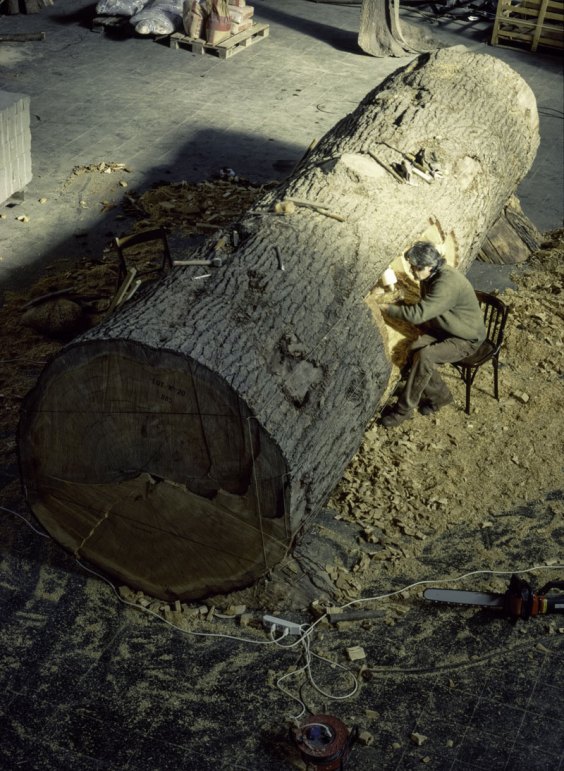
Giuseppe Penone (b. 1947) at work on Cedro di Versailles (Versailles Cedar) (2000-2003) in his studio in Turin. Photo © Archivio Penone
The first thing I notice, as Giuseppe Penone (b. 1947) swings open the door to his studio, is the sweet fragrance of pinewood. Walking into a cavernous warehouse, we are confronted with the vast, capsized trunk of a conifer, and around it various power tools for sawing and carving, and industrial machinery for moving large objects. An adjacent space, a sizeable annex in which works are prepared for exhibition, brings a second timber smell – though this time of packing crates. If, as the artist tells me, these buildings were once used for storing metals, wood is now their presiding material.
It is a ferociously humid day in Turin, and we soon retreat to the relative cool of the modern building that houses the artist’s offices and archive. Penone has worked in the city since the late 1960s, when he came here to study at the Accademia di Belle Arti. While he felt disengaged there, and abandoned his course after a year, his arrival in the city coincided with the emergence of figures including Giovanni Anselmo and Michelangelo Pistoletto who, like him, had chosen to embrace simple materials and unconventional practices; in 1969, he was one of the artists gathered in Germano Celant’s movement-defining book, Arte Povera. Although this was never a formal group – Penone tends to disavow labels or categories that might circumscribe his work – it was, he acknowledges, ‘a definition that allowed for a great many possibilities of expression’.
Penone’s rejection of academic art was a spur to search out those methods and materials he could relate to. ‘It pushed me to work with what I was, in terms of my physical and cultural identity,’ he says. ‘Not having culture, not being knowledgeable about art, the only reality and identity I had was that of the place where I’d been born, with its local reality.’ He started working in the woods around Garessio, the Piedmontese village of his childhood, where he created the Alpi Marittime (Maritime Alps) (1968–78), a series of experimental pieces in which saplings and streams became the protagonists of an art at once unpretentious and unprecedented.

Continuerà a crescere tranne che in quel punto (1968–2003), Giuseppe Penone, tree (Ailanthus altissima) and bronze. View of the work in 2008 Photo © Archivio Penone
Among these works were Continuerà a crescere tranne che in quel punto (It Will Continue to Grow Except at this Point), a steel cast of the artist’s hand and lower arm clasping the trunk of a young tree (the cast is bronze in a later version). The bole would thicken around the metal as years passed, signalling not so much the human effort to corral the natural world, as the way that nature always returns to encompass us. It was a piece that redressed the headlong pace of human time with the slow disclosure of organic growth and change. ‘I feel the forest breathing, and hear the slow, inexorable growth of the wood,’ Penone wrote in 1968. ‘I match my breathing to that of the green world around me, I feel the flow of the tree around my hand placed against the trunk.’
Photographs of the work will feature in ‘Giuseppe Penone: Being the River, Repeating the Forest’ (19 September–10 January 2016) at the Nasher Sculpture Center, Dallas, the first US museum exhibition dedicated to the artist for more than 30 years. The show will include works from five decades in a wide range of media, but it is not, as Penone points out, a traditional retrospective. His career is marked by continuity rather than novelty, at least insofar as it has entailed a series of recurring, interconnected investigations into artistic process, touch and sight: ‘There is no linearity to it, no sense of work developing and running its course…There’s a continuous back-and-forth of thought. I believe that the constant rebounding effect that one has in life is also there in the work.’

Repeating the forest (1980-2014), Giuseppe Penone. Installation view, Musée de Grenoble 2014. Photo © Archivio Penone
Testament to this are the two works that supply the title for the Nasher exhibition. Ripetere il bosco (Repeating the Forest) is an installation that was first shown in 1980, and which brings together pieces from Penone’s Alberi (Trees) series. Starting in 1969, the artist began whittling away at mature timbers, following one growth ring as he stripped back the trunk to its heartwood, and revealing the memory of a sapling buried in the beam. The resulting forms have a delicate, even vulnerable beauty, which combines a phantom sturdiness with a display of disclosed wonder. For the artist, however, the objects themselves are in a sense only products of works in which process is paramount: there is the journey back into the mass of wood to map the history of its growth; the reconciliation of human and vegetal lifespans through contact with the material; and the repetition of this action every year, with a replenished sense of discovery. Ripetere il bosco achieves a type of monumentality, but it is as much a monument to natural flux as it is to sculptural permanence.
Essere fiume (Being the River), a series of works that began in 1981, is another longstanding inquiry into a natural process, and how it relates to the action of the sculptor. In these works, Penone prizes a small boulder from a riverbed, before travelling to the source of that river where he extracts a slab of stone which is the geological counterpart to the first. This he sculpts, following the contours of the original rock, his own actions replicating its erosive transportation downriver. ‘There are the ricochets, the moments of shock, the friction,’ he says, ‘a whole series of things that are very similar to what occurs in making sculpture.’ But the trip upstream also feels like a metaphor for the artist’s mind, with its persistent return to the same dependable starting points from which to leap back into the flume of ideas.
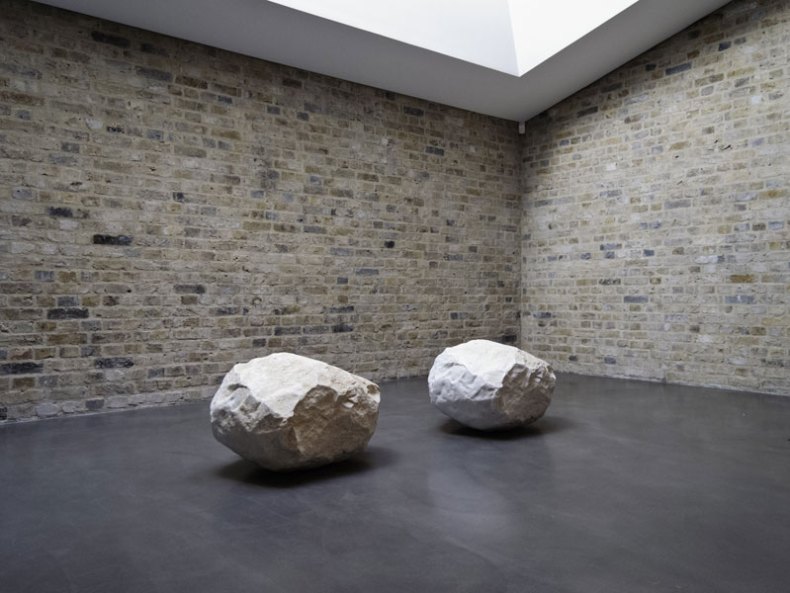
Essere Fiume 7 (Being the River 7) (2000), Giuseppe Penone. Installation view, Whitechapel Gallery, London 2012 Photo © Archivio Penone
I ask whether these works hold on to a memory of place, whether the trees and rocks retain the specificity of their landscape when they are transposed to the studio or the gallery. But like Richard Long, an artist whom he admires, Penone is cautious about the localism of such rooted detail, preferring to think in terms of the universality of his materials, and of the simple forms that he realises in them: ‘If a rock has a certain value in a village, it has the same value in a city,’ he says. It is a mode of thought, he explains, that is traceable in his mind to the artistic developments of the 1960s and ’70s, when a new internationalism propelled artists to look beyond national traditions and contexts in search of more common idioms. ‘If an artistic language is very complex, it can’t be used to communicate.’
That was also a sculptural moment, to the extent that the leading proponents of the Arte Povera, Land Art and conceptual art movements concerned themselves with the conventional frontiers between artistic disciplines at all. ‘There are times in history when sculptural expression takes precedent over pictorial expression,’ says Penone, ‘as in the 1970s, when there was a need to redefine reality with a different language.’ For many artists, this involved a rejection of figuration and abstraction, ‘reducing formal invention to a minimum, and seeking to isolate the contents of the material or of one’s expressive language.’ But for Penone, it also meant the adoption of traditional, durable materials – among them wood, clay, marble, granite, bronze and glass – which had been used for millennia by figurative sculptors but now became the focus of the work itself. (He has often spoken of how tautology was a liberating force for post-war artists, from Yves Klein’s blue objects to the flag paintings of Jasper Johns.)
Such materials appealed because of their constancy – a constancy that has nonetheless always incorporated the slow creep in their chemical composition, which largely takes place beyond the level of perception. Of bronze, he has always been fascinated by the specificity of patinas, and refers me to a passage in Plutarch in which visitors to the sanctuary of Apollo at Delphi debate the patinas of a group of bronzes. The persistence of his favoured materials is in contrast to synthetic materials or digital technologies, he tells me, which have neither an ancient provenance nor any promise of permanency:
‘I think that the modernity of a work doesn’t come by way of its material…If you consider technology, it’s a material produced by human activity, so all you need is for our way of life to change and that material will no longer exist. The work has a very limited duration.’
Penone’s research into the properties of materials is partly about acceding to man’s place in the natural world; acknowledging human transience, that is, and recognising that the body assumes a sculptural relationship to the spaces it inhabits. Both aspects are present in the Soffi di creta (Breaths of Clay) series of 1978, works in which the shape of a human breath takes material form in clay standing sculptures that have the appearance of misfired amphorae. On the one hand, these pieces grant a monumental mass to what is momentary, but on the other they make visible a projection of the body into space that is a fundamental condition of being alive. ‘Breath is automatic, involuntary sculpture,’ Penone wrote in 1977, ‘that brings us closer to osmosis with things.’
In another text from 1999, the artist wrote that ‘The desire for an equal relationship between my person and things is the origin of my work. Man is not a spectator or actor but simply nature.’ It is through the sense of touch that Penone has most fully approached this equivalence, particularly in works that dwell on how the skin gathers information about the world, or how sight propagates conventions or deceptions. The most well-known images of the artist, of course, are archive photographs from the Rovesciare i propri occhi (Reversing One’s Eyes) project of 1970, in which he wore mirrored contact lenses that rendered him temporarily blind. These threw back a fish-eye miniature at the viewer, as if the convex mirror in Van Eyck’s Arnolfini Marriage had been propagated before being installed on the artist’s corneas. With the benefit of hindsight, the work feels like something of an artist’s statement: of Penone’s pressing desire to move beyond a reliance on sight, towards a more direct and haptic relationship with the world.
‘Tactile experience and physical contact give the true dimension of things,’ he says, adding that they are also fundamental to artistic process: ‘Not having a direct relationship with the material, but only a concept, or an idea of making a work to match an image conceived in the mind, isn’t fertile over time – it doesn’t produce many things.’ I think back to Continuerà a crescere tranne che in quel punto, and its fossilisation of a moment of touch, around which the artwork symbolically grows and develops. From the outset, the skin and its traces make their mark throughout Penone’s oeuvre: in the Propagazione (Propogation) drawings of the mid 1990s onwards, which blossom outwards from the epidermal cartography of a fingerprint, for instance; or in Spazio di luce (Space of Light) (1998), a tree cast in bronze through the lost wax technique, its surface autographed with the fingerprints of those foundry workers who modelled it. Prints stand in for tree rings, permitting person and things to coalesce; but their diverging scales are a reminder of what typically precludes such equivalence.
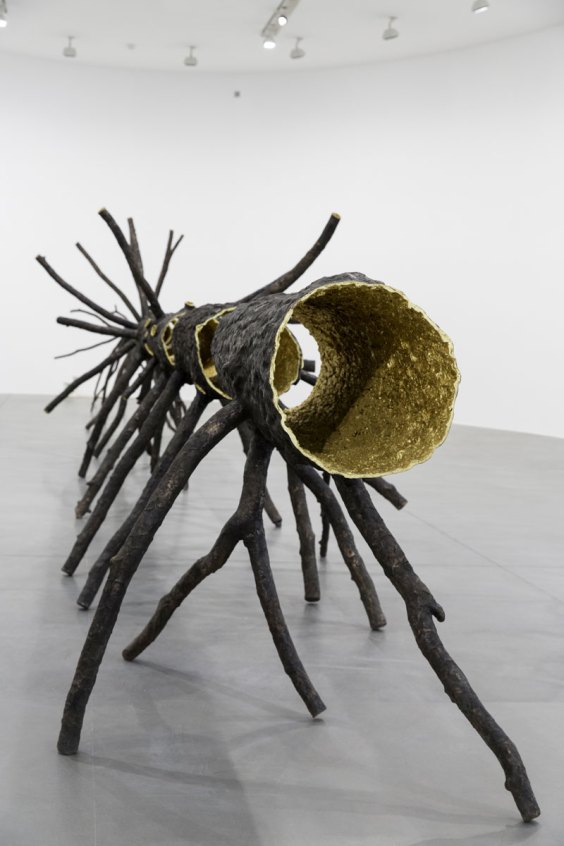
Spazio di luce (2008), Giuseppe Penone, bronze and gold, eight elements. Installation view at Gagosian Gallery, Rome 2015. Photo © Archivio Penone
Penone is a man and artist of integrity, whose work takes little heed of the demands of exhibition makers or the market. When I ask about site-specific work – one bronze tree, L’albero delle vocali (The Tree of Vowels) (1999–2000), is permanently installed in the Tuileries Gardens in Paris – he stresses the obligation for the artwork to succeed on its own terms: ‘Making a work with the sole aim of furnishing a space leads to a work that isn’t interesting, that has a brief life. The motivation for a work needs to be deeper.’ He is wary, too, of how today’s museums seem to exist to create exhibitions, which are often governed by concepts that confine the art: ‘the museum has become a structure that produces exhibitions, which creates a certain type of artist who works for museums; you risk having works that have lost any independence from the cultural system.’
Penone has always striven for this independence, and it is writ large in both the processes and products of his art. The works that will be shown at the Nasher Sculpture Center are the result of long gestation – and are works that continue to gestate, even now.
‘Giuseppe Penone: Being a River, Repeating the Forest’ is at the Nasher Sculpture Center from 19 September–10 January 2016.
Click here to buy the latest issue of Apollo
Unlimited access from just $16 every 3 months
Subscribe to get unlimited and exclusive access to the top art stories, interviews and exhibition reviews.


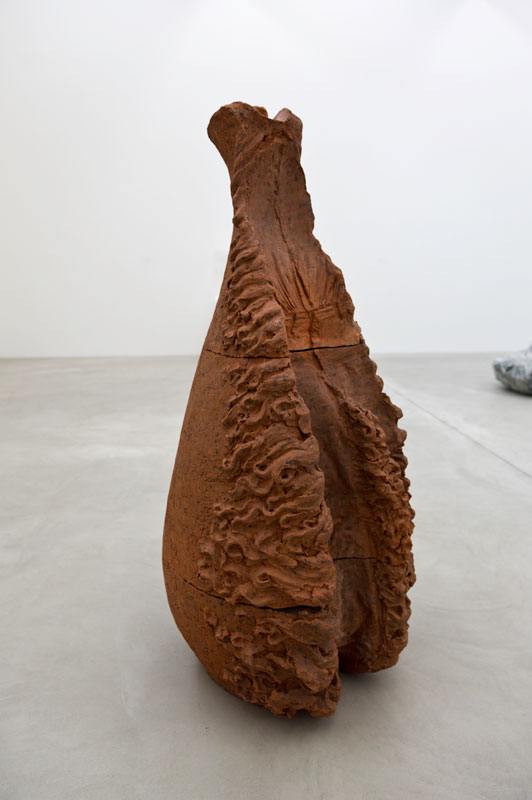

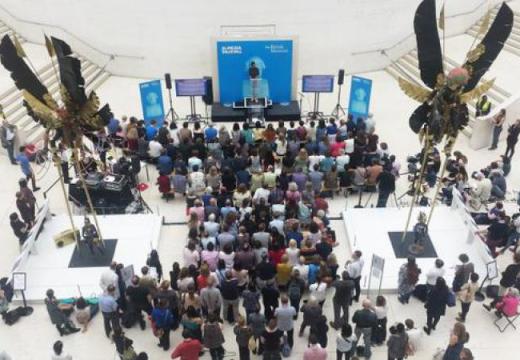
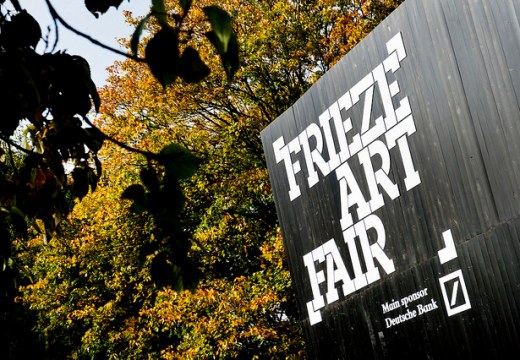









![Masterpiece [Re]discovery 2022. Photo: Ben Fisher Photography, courtesy of Masterpiece London](http://www.apollo-magazine.com/wp-content/uploads/2022/07/MPL2022_4263.jpg)
It’s time for the government of London to return to its rightful home